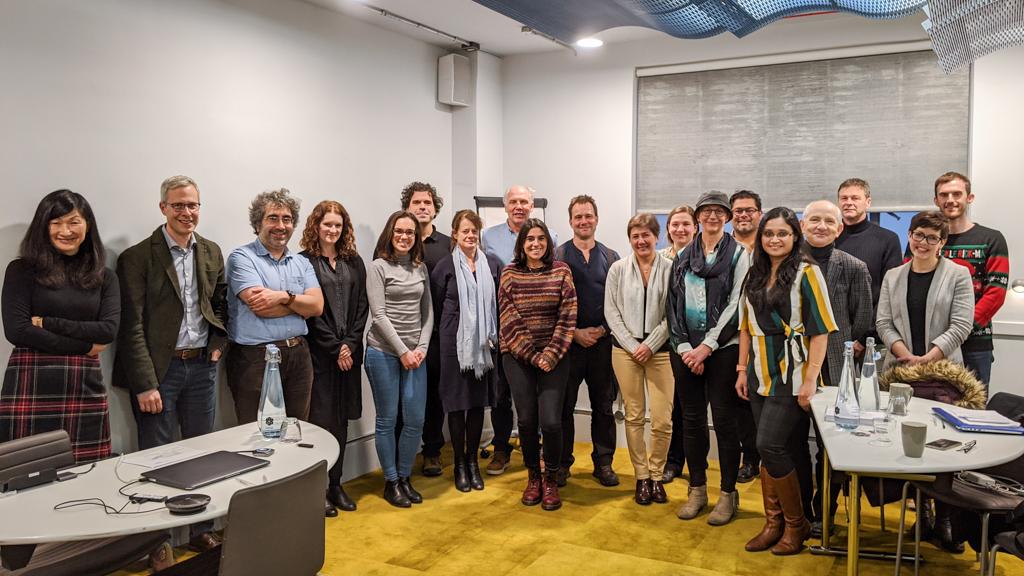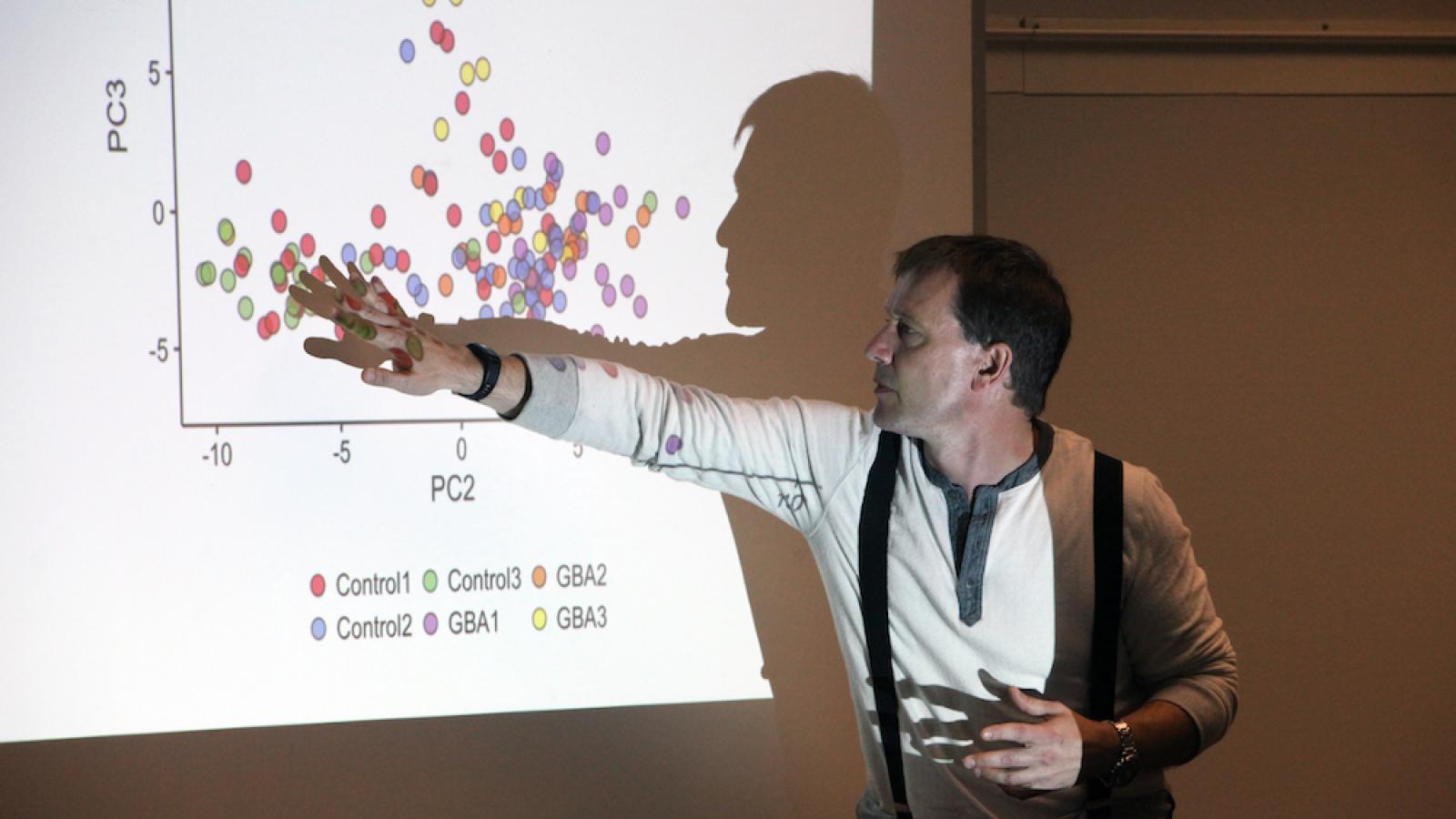To be successful in drug discovery, researchers must look beyond their own work to the bigger picture, and identify opportunities to set in motion the steps necessary to translate discoveries into treatments. This process can’t be undertaken alone – it necessarily means involving other key partners, including industry, and problem solving in new ways. It can be a daunting task, but is a fundamental step in making our research have real-world impact, especially when facing a challenge like dementia, for which there are currently no disease-modifying treatments. For Professor Caleb Webber, Group Leader at UK DRI at Cardiff, this comes naturally, and the process of meeting, discussing and discovering with others is one of the most enjoyable and rewarding aspects of the job.
“It's comparable to when you used to go round to a friend’s house and they'll play you some new music you’ve never heard. Finding out about new science is like discovering a new band as a teenager. I love working with people and hearing about new areas of biology.”
Professor Webber is a self-confessed ‘dot-joiner’. Whether he’s seeking out the missing link in a genetic pathway or playing matchmaker at a workshop, he is always looking to build new networks in the pursuit of solving the complex puzzles behind brain disorders. As the informatics theme lead at the UK DRI, Professor Webber convenes experts in discovery research to exploit the full potential of data generated from the institute and reveal novel insights into disease mechanism. This exercise is crucial given the current paucity of successful therapeutic targets in the neurodegeneration field.
In his own research programme, he is aiming to identify common processes and genetic pathways that underpin the diseases that cause dementia. Unusually, his lab is an equal mix of cell biologists and bioinformaticians, demonstrating his success at seamlessly dovetailing these two disciplines. The team start by probing a set of candidate genes that may be impacting disease, finding out which cells they are expressed (present) in, what their function might be and what else they interact with to build potential disease networks. He believes that by studying gene expression through analysis of the transcriptome, scientists can begin to understand what the cell is ‘thinking’ in the earliest stages of disease.
“If you look back at medicine in the past, the patient went to a doctor who would examine them and tell them what was wrong. Modern medicine takes a different approach by asking the patient about their experience. In a similar way, I like to ask the cell what it thinks is going wrong, and we do that through systematic measurement of gene expression.”
To bridge the gap between discovery research and the clinic, Professor Webber has designed a series of elegant experiments using induced pluripotent stem cells. First, he measures the gene expression of cells exhibiting disease. Next, the team look at the gene expression profiles from healthy cells that receive a drug dose. By comparing these profiles following disease and drug administration, he is able to match treatments that oppose the effects of the disease.
We must remember that in order for industry to take forward these experiments, they have to believe in the assays being used.Professor Caleb WebberUK DRI Group Leader at Cardiff
This approach has proved successful over the past decade. In 2017, Professor Webber’s group showed that the anti-malarial drug clioquinol is a good candidate treatment for Parkinson’s disease and more recently in 2019 proposed the anti-cancer drug Tasquinimod. However, there is still room for improvement, for example in meeting challenges around matching current cellular models to available candidate drugs. Professor Webber believes this is an area in which academia and industry can work together.
“As academics, we can only really work with what we have. I enjoy partnering with industry on a range of projects, such as exploring alternative applications for failed drug compounds, or using anonymous expression profiles for new ones in development. We must remember that in order for industry to take forward these experiments, they have to believe in the assays being used. The assay is everything and improvements here, through collaboration between academia and industry, could make a huge difference.”

Professor Caleb Webber and attendees at the UK DRI iPS cell microglia workshop in December 2019
Suck it and see
From the first time we carry out a scientific experiment in school, we are taught to lead with a hypothesis – what do we expect the result to be. It is the foundation of the scientific approach. But when speaking to Professor Webber, it is surprising to hear that he believes our devotion to this idea is holding back the research community.
“I think as academics, we find ourselves trapped in areas of study. We need to learn to fail faster and move onto new ideas. It’s very difficult to stop working on something you have been studying for a long time, particularly if your livelihood and that of your lab depend on it. But millions of pounds are being wasted every year when we keep going down these paths, following one hypothesis, with little success. If we can design our experiments to allow us to drop ideas and pick up others, we will find new leads quickly and maintain momentum with our research.”
Professor Webber recently demonstrated this type of thinking when working with colleagues to create a gene atlas for Parkinson’s disease. The team took a ‘bigger picture’ approach by sequencing the genetics from thousands of cells in the Parkinson’s brain and comparing this to data from large population studies, to pinpoint the risk genes and cell types they are expressed in. As expected, there were associations with dopaminergic neurones, the cells that are known to degenerate in the disease, but surprisingly the study also pointed to a role for oligodendrocytes, a support cell for neurones in the brain.
“We had no reason to suspect oligodendrocytes were involved and we probably wouldn’t have got the grants to look anyway if we had put forward that hypothesis. But because we looked at every cell type by harnessing a multi-omics approach, we now have new leads to follow in the search for Parkinson’s therapeutics.”
Joining UK DRI as a Group Leader, Professor Webber believes the five-year funding structure at the institute allows for this flexibility and exploration of new ideas.
“I feel there is a trust that you'll follow the best science and then you will be judged on that. When things become very prescriptive, they become very wasteful. If you work in multi-omics, you’ll find everything can change in six months, making it very difficult to predict where your research will be in years to come.
The nature and strategy of the institute is also very appealing to be a part of, as you have so many people with different skills. I love to take my problem to other researchers and find out how they would approach it. These projects are opening up many opportunities for researchers to come along and plug in their technologies or expertise. I think there's a real cross-fertilisation which goes on when you bring people together. It adds a freshness that, when combined with our previous knowledge, allows us to think about things in completely new ways. And that's only going to accelerate science and help us to develop treatments more rapidly.”
For more information or to explore partnering opportunities with any of the UK DRI Group Leaders, please contact UK DRI Director of Innovation and Business, Dr Kay Penicud.
Article published: 12 January 2021
